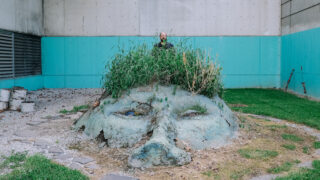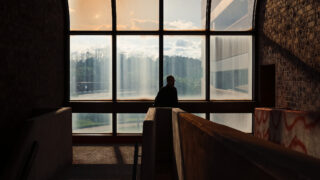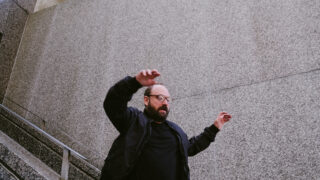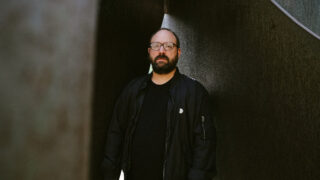G.S. Schray: ambient free jazz from the Midwestern Mark Hollis
In conversation with the Akron maverick and his 22-year-old cat

In conversation with the Akron maverick and his 22-year-old cat
When Talk Talk entered Wessex Studios in 1987 to record Spirit of Eden, the brooding younger sibling to their exemplary synth-pop records, the group were – literally and figuratively – in the dark. Today, those sessions are talked about with a perplexed enthusiasm for the lengths the band went to in order to achieve a specific mood for their reactionary release. A darkened room offset by oil-lamps and strobe lighting provided an unconventional setting for a revolving cast of musicians to improvise for extended periods. As you can imagine, such surroundings had disorientating effects for those involved. This seismic shift in Talk Talk’s repertoire signified the end of the party for their mainstream hits. 33 years on, the resulting Spirit of Eden, an enduring influence on contemporary artists, seamlessly encapsulates the immersive and impenetrable environment in which it was conceived. Its midnight-hued tonal palette provides a perfect backdrop for ‘The Rainbow’s organ flourishes and the choral segment on ‘I Believe in You’ to illuminate and elevate the record.
Listening to The Changing Account, the third LP from Akron-based musician G.S. Schray released via NTS Radio’s label Last Resort, Talk Talk’s post-rock influence permeates Schray’s experimental soundscapes. This is most evident on tracks like the glorious ‘Two Pals Glowing’; moreover, that band’s process of splicing sections from the hours’ worth of session material mirrors Schray’s own method of configuring his meandering arrangements.
“For this record, I laid down some drum tracks at a friend’s studio,” he explains over a Zoom call from his Ohio home. “Other than that, everything was done in this room, actually. A couple of friends called over and improvised over tracks, then I chopped those samples up and arranged them. No one’s really performing as such, including myself. It was all sort of pieced together like a model aeroplane!” While Schray didn’t necessarily work in a dimly-lit studio or remove himself from the concept of time to reach a particular sound for his latest offering, there’s an undeniable grey-scale cast upon these eight enveloping compositions.
Fusing meditative melodies and loose instrumentation comprising electronic and organic sources, The Changing Account benefits greatly from its slumberous spaciousness. The subtlety of the textures reveals more of its intricacies with each listen. Recorded between 2019 and 2020, the album found its way to audiences in March of this year and the reception has been overwhelmingly positive. “It’s always so funny to read reviews that have come in for these past three albums I’ve put out with Last Resort because, invariably, people refer to the music as Balearic and New Age. To a lot of critics it seems to evoke a Mediterranean sunset. I absolutely love that, but at the same time, I find it completely wild because all I hear is grey, mid-west, open spaces. It’s really interesting to me that other people’s touchstones for my music tend to be wildly different to mine.” Schray chuckles.

Those touchstones often herald the likes of Angelo Badalamenti, via glacial synths across ‘Still, Puzzled’, and the Durutti Column in the zingy guitar riff that takes centre stage on ‘In Select Everything’. In honing his strand of ambient free jazz, Schray mentions two formative influences on his teenage years in Ohio; local underground scenes and the band Tortoise. “I was probably 17 or 18 years old when my friends and I discovered that there was an underground music scene a few miles east of us in Kent, Ohio,” he explains. “There was a really cool scene there of people a little older than us playing music. My friends and I had been in bands before that, mostly indie rock or punk rock. I feel like that community, and then discovering Tortoise around the same time, set the trajectory for my interests. Everything kind of branches off those two things.”
Years later, Schray continues to nurture a tight-knit underground community in his home state, also performing in Lemon Quartet, while Last Resort labelmate Keith Freund has contributed artwork for Schray’s three records. The inherently DIY aspect to his music, which extends to making his music videos, heightens the overall experience of sitting down with his work. Within this extended Akron scene, Schray is an enigmatic figure; beyond his music, information about him or his musical background is scarce. On Twitter, he frequently retweets images from an account dedicated to sharing screenshots from Gumby: The Movie, a 1995 surrealist claymation film; on Instagram, he posts pictures of his pets alongside striking monochromatic illustrations of them and various individuals. All of these seemingly inconsequential online habits are, in fact, important aspects of his work. If you look closely, you’ll spot a legless clay model in the artwork of his latest LP.

At the midpoint of our conversation, Gabe pauses his train of thought to let his 22-year-old (!) cat, Jarvis (named after the Pulp frontman) into the room and onto his lap, where he’ll remain for the rest of our conversation. Furry friend taken care of, we return to the importance of film and art in his overall artistic expression. In February of this year, Schray animated a striking video for the album’s closing track, ‘Eye on the Menace’. “I’ve been messing around with animation for the past few years; I’m a dabbler. I don’t take it too seriously, though,” he chuckles. Given the sophistication of the visual and aural components of his recent output, coupled with a Frankenstein approach to producing his work, one would assume his home studio is filled with an array of interesting gadgets. On the contrary; his setup is rather understated.
“I’m not really into toys all that much. I guess I have a couple here. I don’t know if you can see, but this would be my favourite toy,” he says, leaning back in his chair and gesticulating towards a double bass. “My friend Ben down in Columbus, Ohio gave it to me because his kids were inserting Lego into it. I’m not sure if I’m treating it much better, to be honest. I do a lot on my computer now because I find it’s the easiest path to follow through on an idea.”
Ideas have come steadily to Schray since releasing his 2017 debut, Gabriel. Not much time has elapsed between releases, however he’s noticing his creative bursts slowing down. “I’ve been feeling no inspiration at the moment. I don’t worry about writer’s block, I try not to look at it like that. I’m happy to wait for something to come to me. It seems that periods of creativity happen further apart as I age. At the moment, I’m keeping my antenna up!” This way of considering his creativity, the image of the antenna, is one cultivated by director and musician David Lynch; another source of inspiration for Schray. “He’s huge, definitely. My older brother introduced me to Lynch’s movies when I was growing up. I remember watching Twin Peaks when I was too young to be looking at it. It’s such a great show; the vibe of that really stuck with me. I know Lynch is an obvious touchstone for inspiration, but I love him. Especially his artistic philosophy of being an antenna, helping ideas out to the world and you’re just a conduit. It’s cool!”

In these recent quieter times, Schray has turned his attention to music documentaries and going down YouTube spirals. Recently, he’s been enjoying old footage of Sunday Night, later known as Night Music, a televised series hosted by Jools Holland and David Sanborn in the late ’80s. “I got really obsessed with watching that because it features music I wouldn’t have naturally encountered. I get the impression it was originally targeted to people who were in their 30s in the late ’80s. The majority of the guests come from jazz influenced pop disciplines. But then they’ll have The Residents or Sonic Youth or a younger band. It’s a really weird show! I’ve had a lot of fun delving into it because it’s like a survey of this really specific genre and really specific era. I don’t know if it’s that I’m finally the age that it was aimed for. It’s a really fun way to discover new things.”
Listening to G.S. Schray’s music, its mellow nature suggests he’s a laidback guy. He’s extremely easy and fun to talk to about a variety of topics, from Night Music to his disdain for recent rock memoirs penned by Dean Wareham and Chris Frantz, respectively. He’s also extremely forthcoming and thoughtful when discussing his music and the direction he wants to take it in the future. Here, his mindset and willingness to eschew mainstream expectations and trends echoes Talk Talk’s Mark Hollis circa 1987. “Yesterday I started working on a tune for a compilation somebody asked me to be part of. I mentioned earlier that I haven’t been inspired to make music since [The Changing Account] came out. This project’s got the gears turning and I was enjoying it,” he says with a smile. “I’m getting a little tired of, how do I put it, a zeitgeisty thing in indie music now where there’s a lot of music being made to chill you out. I think it has a lot to do with Covid-19, this idea that people need something to calm themselves. It seems like there’s a glut of music being described that way. I can see it congealing into a pretty stale thing. And like I said earlier, I don’t see my music that way but if other people do then I guess that’s true to a certain extent. So now, I want to make something that’s ugly and a little more anxious. I think I might go in that direction. I don’t know, I guess it’s sort of a reactionary thing on my behalf.”
Photography by Jenn Kidd